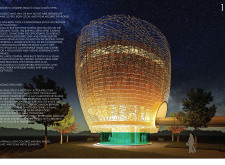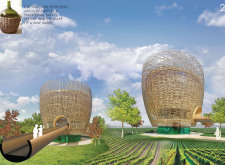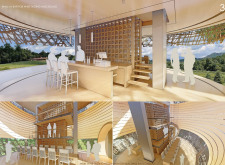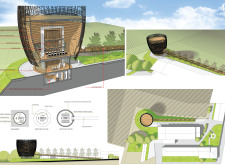5 key facts about this project
The building's unique form draws inspiration from wine barrels and traditional weaving, symbolizing the artisanal nature of winemaking. This approach allows for a blend of cultural significance and modern architectural trends. The integration of natural materials, such as light-colored wood and glass, enhances the aesthetic appeal while ensuring sustainability. The layout is organized across three levels: the ground floor houses the bar and retail space; the second level features a panoramic tasting room; and the basement includes essential facilities. This thoughtful distribution of functions creates a natural flow throughout the visitor experience.
Spatial Organization and Unique Design Approaches
The project showcases several distinctive design approaches that set it apart from conventional winery visitor centers. The open lattice structure utilizes light-colored wood, allowing for ample natural light and ventilation while providing a sensory connection to the vineyard. Large glass panels frame views of the surrounding landscape, encouraging a seamless transition between indoor and outdoor environments.
A focus on vertical circulation enhances the spatial dynamics within the building, with wooden stairs serving not only as pathways but also as structural elements that contribute to the overall aesthetic. Acoustic considerations are integrated into the tasting areas to facilitate quiet conversation and enhance the enjoyment of the wine tasting experience. The landscaping surrounding the center is meticulously arranged to complement the architecture, positioning greenery to invite users into a cohesive relationship with nature.
Functional Elements and Materiality
The architectural design prioritizes functional requirements while maintaining a cohesive visual language. The ground floor's layout is open and inviting, providing easy access for visitors. The tasting room on the second floor is intentionally designed for group gatherings and private events, allowing for enhanced engagement with the wines being served.
Material selection aligns with environmental sustainability. The use of natural wood and glass not only reinforces the connection to the vineyard but also promotes energy efficiency through passive heating and cooling strategies. Metal elements in the structure provide necessary durability, securing the integrity of the building over time.
To gain deeper insights into this winery visitor center project, explore the architectural plans, architectural sections, and architectural designs that illustrate these distinctive features. The innovative architectural ideas presented in this project make it a noteworthy example in the context of winery visitor centers. Consider reviewing the details further to appreciate the comprehensive approach to design and functionality inherent in this undertaking.


























